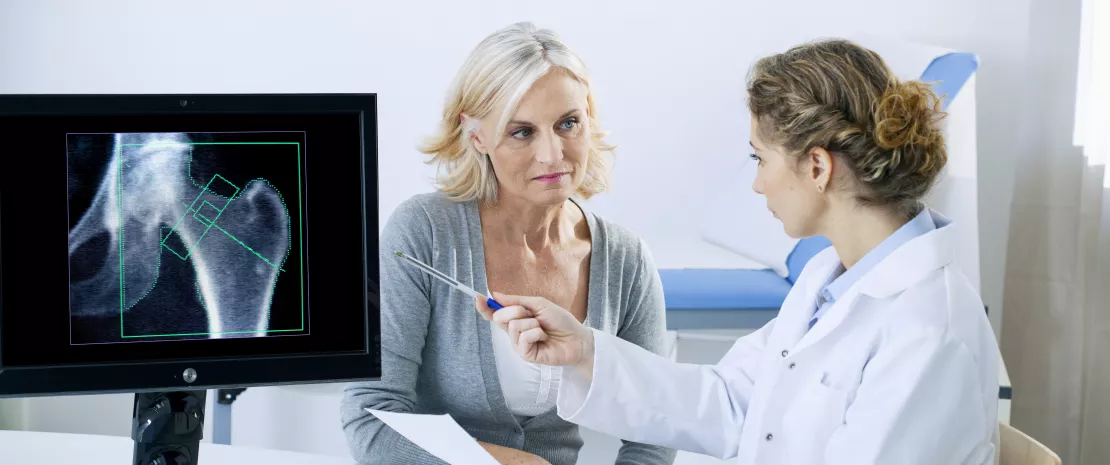Osteoporosis: how the microbiota can weaken bones
Will we ever be able to prevent and treat osteoporosis by acting on the gut microbiota? This is possible according to the results of a Chinese study published in the journal Frontiers in Immunology.
- Learn all about microbiota
- Microbiota and related conditions
- Act on your microbiota
- Publications
- About the Institute
Healthcare professionals section
Find here your dedicated section
Sources
This article is based on scientific information

About this article
Osteoporosis, which affects nearly 30% of women over the age of 50, is a major public health problem characterized by bone weakening likely to lead to repeated fractures. The mechanisms involved in this disease are not fully known, but a growing number of studies suggest that inflammation could increase the risks.
One in three women Has osteoporosis after menopause. Men are not spared, as one in five men suffers a fracture due to osteoporosis after the age of 50.
Gut microbiota: still an underexplored avenue
We know that certain microorganisms in the gut and vaginal microbiota can modulate the immune response and impact the inflammatory system. Could they be implicated in osteoporosis? This is what researchers from the University of Zhengzhou in China tried to find out.
They enrolled 132 women between the ages of 45 and 70, all menopausal for over a year, and divided them into 3 groups based on their bone density: “no bone problems,” “slightly decreased bone density” and “osteoporosis”. The scientists collected stool and vaginal secretions from all of these female volunteers to analyze and compare their vaginal and gut microbiota.
Results: The microbiota of women with osteoporosis have different compositions than those of the other two groups, and this difference is particularly visible at the gut level (1).
The gut microbiota
Inflammation-promoting bacteria
The gut flora of women affected by osteoporosis was richer in bacteria whose presence is associated with a lower level of interleukin IL-10, a molecule with anti-inflammatory properties, and also in bacteria associated with the production of “pro-inflammatory” cytokines that contribute to bone destruction.
On the other hand, it was poorer than the others in bacterial species producing butyrate, a (sidenote: Short chain fatty acids (SCFA) Short chain fatty acids (SCFA) are a source of energy (fuel) for an individual’s cells. They interact with the immune system and are involved in communication between the intestine and the brain. Silva YP, Bernardi A, Frozza RL. The Role of Short-Chain Fatty Acids From Gut Microbiota in Gut-Brain Communication. Front Endocrinol (Lausanne). 2020;11:25. ) (SCFA) with anti-inflammatory properties, and in bifidobacteria, which improve the intestinal absorption of calcium, essential for good bone density.
With regard to vaginal microbiota, women suffering from osteoporosis had, compared to the others, fewer lactobacteria, known to attenuate the inflammatory response and its harmful effects, and more streptococci which, to the contrary, promote it.
Bone, a constantly changing tissue
Did you think that the bone, once it has reached its maximum size, does not change? Think again! The bone is constantly being remodeled, even in adulthood. Two types of cells are involved in this phenomenon: osteoclasts, which break down old bone, and osteoblasts, which form new bone. When we are healthy, their respective activities are balanced, and the bone is constantly regenerated. However, at menopause, the lack of estrogen promotes the action of osteoclasts and slows down that of osteoblasts: bone is resorbed more and its architecture becomes fragile. This is osteoporosis. (2)
Toward targeted therapies to better prevent osteoporosis
For the researchers, these compositional changes are fundamental. They could one day be used to develop targeted therapies or serve as biomarkers to better prevent osteoporosis.
1. Yang X, Chang T, et al. Changes in the composition of gut and vaginal microbiota in patients with postmenopausal osteoporosis. Front Immunol. 2022 Aug 12;13:930244.
2. Florencio-Silva R, Sasso GR, et al. Biology of Bone Tissue: Structure, Function, and Factors That Influence Bone Cells. Biomed Res Int. 2015;2015:421746.












